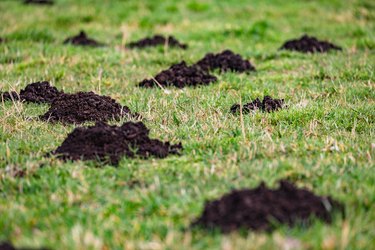
Any number of insects or animals might leave mounds of dirt in a yard, but the easiest way to determine the identity of the suspect is to consider the shape and size of the piles. Tiny piles usually indicate earthworms and occasionally insects, while larger mounds are most often caused by burrowing animals.
Mini Earthworm Mounds
Video of the Day
Earthworms are common burrowers, but it's not their burrowing that leaves behind little clumps of dirt. These piles are actually worm castings, which is a nicer name for worm poop. Nutrient-rich worm castings are great for the soil, and they'll eventually mix into the soil on their own.
Video of the Day
Worm castings aren't harmful to the yard, and there's no need for concern. Even the earthworms themselves benefit the soil, as they aerate it when they burrow. Mounds of worm castings have no hole in the center, whereas mounds left by something else often do.
Mole Cricket Mounds and Anthills
Mole cricket mounds look similar to piles of earthworm castings from afar, but there are a few differences. Worm castings look like granules of dirt stuck together, whereas mole cricket mounds have a hole on top. The cricket's mound looks more like something pushed the dirt up from below; it's also similar in appearance to an anthill.
Seeing ants nearby usually indicates that it's an anthill. Knocking it over a bit may verify the assumption, as more ants should come out. Pouring soapy water over the hill is another option. Mole crickets quickly vacate their mounds when flushed by soapy water.
Mounding Mole Hills
Moles, which average 4 to 7 inches long, burrow just beneath the soil surface, often leaving raised paths in the dirt in addition to their mole hills. Their hills are cone-shaped and might not have an obvious hole on top. The mound may be a lot wider than it is tall. Prolific burrowers, moles can create 150 feet of tunnels in one 24-hour period. These creatures dig to feast on other things burrowing in the soil, such as grubs or earthworms.
Larger Animals, Larger Mounds
Larger burrowing animals also leave mounds of soil in the yard, but the species varies depending on the region in many cases. Various gopher species leave piles of dirt in yards, but these piles are not usually cone-shaped. Instead, gopher dirt piles are arc-shaped, with the hole, sometimes plugged, near the center base area opposite the curve. Both pocket gophers and larger gophers create similar pile shapes, but pocket gopher mounds are relatively small compared to the mounds left by large gophers.
Groundhogs leave rather large holes in the ground along with piles of dirt that came out of such holes. If there's a pile of dirt large enough to notice it from afar, look for a hole nearby. A groundhog hole is up to 1 foot across, and it may not be obvious until you're next to the dirt pile that came from it.